 Research Article
Research Article
Italians’ Public Opinion on the Road Roundabouts Safety
Natalia Distefano* and Salvatore Leonardi
Department of Civil Engineering and Architecture, University of Catania, Italy
Italians’ Public Opinion on the Road Roundabouts Safety
Received Date: January 08, 2019; Published Date: March 14, 2019
Abstract
Roundabouts have been shown to provide significant safety and operational benefits, but a better understanding of public perceptions of roundabouts is critical in order to assess the contribution of the driving behavior of the users on their safety. Therefore, research on user behavior and preferences is a helpful tool in improving road safety and accident prevention. The aim of this study was to increase knowledge about user perception of risk in roundabouts. Risk perception in specific situations, factors influencing perceived risk, and attitude towards suggested safety improvements were studied as well as knowledge about traffic rules regulating the interaction between road users was studied. The instrument used is a web nationwide survey, which resulted in a total of 1728 responses throughout Italy. These results provide a macroscopic view of road user perceptions of roundabouts at a statewide level. This study also showed that web-based surveys provide an efficient means of collecting detailed public opinion data. The overall opinion that the respondents expressed against roundabouts is positive. However, the survey results have shown that the judgment suffers significant variability in relation to some specific components of the people. It is different the degree of safety of roundabouts towards the different types of users (for example, are considered less safe against cyclists). There are no substantial differences between the judgment of male drivers and that of females.
Keywords: Road safety; Driving behaviour; Web-survey; Risk perception; Ordered probit models
Introduction
Risk perception being a very common psychological phenomenon can affect road safety attitude directly as well indirectly. From a theoretical perspective, risk perception is considered a crucial factor in understanding the process of behavioural change. It refers to the subjective interpretation involved in different traffic situations [1]. Brown & Groeger [2] suggested that this perception is determined by information regarding the potential hazards in the traffic environment and information on the ability of the actor to prevent those potential hazards from being transformed into actual accidents. Perception of risk of road accidents by drivers can make them to adopt the behavior that helps in preventing road accidents. Risk perception affects drivers’ attitude regarding traffic rules, non-driving activities and driving responsibility [3]. Risk perception can modify human behavior. Risk perception affects drivers’ attitude regarding traffic rules, non-driving activities and driving responsibility.
Persons who possess high level of risk perception are more likely to be cautious and careful in their behavior. Risk perception helps in adoption of protective behavior. Risk perception is determined by the information of the potential hazards in traffic environment, and on the ability of driver to perceive the potential hazards resulting into actual accidents. There is a significant relationship between risk perception and road accidents [4]. Risk perception significantly indirectly affects the risky driving behavior [5]. Risk perception depends upon driving training, driving experience, age of drivers, etc. Driving training increases risk perception of drivers [6]. The age of driver influences risk perception and risktaking behavior [7]. Ulleberg & Rundmo [8] have shown that risk perception is significantly related to risky driving behavior and risk-taking attitudes. There is a positive correlation between risktaking attitude and risky driving behavior [9]. Risk taking attitude predicts risky driving behavior. Risk taking attitude comprises rule violations, speeding, careless driving, and drinking and driving. A study explains that risk perception and perception of driving tasks significantly affect drivers’ road safety attitude which comprises attitude regarding traffic rules, driving responsibility, non-driving activities, carelessness and aggressive behavior [3]. Higher drivers’ perception of risk and driving tasks more will be the improvement in their road safety attitude.
The aim of this study is to understand how the road roundabouts are perceived by people from the point of view of safety. It is known as the roundabouts represent the type of intersection that, from the point of view of the level of safety offered and the guaranteed operational performance, enjoys the highest consensus by the technicians of the sector. The goal is to understand whether the “technical agreement” corresponds to a similar level of support from the public. Numerous studies conducted internationally have allowed to quantify within a range between 10% and 40% decrease in the accident rate due to the construction of roundabouts in place of other types of intersections. The most obvious effects will have in cases where the takeover roundabouts at stop-controlled intersections. Smaller, but significant, are the benefits of the road roundabout in the redevelopment of signalized intersections. Distefano et al. [10] have quantified the extent of the relationship between the safety perception of the typical roundabout maneuvers and the following aspects: a) maneuver type, b) geometric characteristics of the roundabouts design elements. Brilon & Stuwe [11] have documented that the average diameter roundabouts (up to 40 m) are safer intersections signal regulated, while those of larger dimensions, while presenting accident rates often higher than those of signalized intersections, however, are zones of accidents less serious. Persaud et al. [12] have also shown as the accidents of greater severity (fatal or serious injury), are reduced, in the case of roundabouts, according very high percentage (70% - 90%).
Data Collection
In order to assess public perception of roundabouts for Italian people, the tool used was a web-survey. The questionnaire was designed by the authors of this paper and includes both general questions (age, gender, education, means of transport used most frequently), which targeted questions to capture information on the opinion of the interviewee on the safety level that he personally perceives roundabout. The first set of questions will be used to characterize the user in relation to the answers relating to the perception. The survey was conducted via web through the DISS website (Road Safety Centre). A total of 1728 survey responses were received during the implementation period from May to July of 2016. Details of the characteristic of survey respondents are presented in Table 1.
Table 2 shows the answers of respondents to questions designed to understand the level of knowledge of the rules of behavior in the roundabout. Most drivers believe that a roundabout need to be travelled while maintaining a constant speed (in entry maneuver, in circle on the circulatory roadway and in exit maneuver). It is true that it has the knowledge that in entry maneuver should decrease the speed, but it is not, however, aware that it is necessary to increase the speed on circulatory roadway and also at the exit in order to quickly dispose of the vehicle flow. Almost 20% of respondents believe that on circulatory roadway should take place at a lower speed than the entry maneuver (Table 2).
Table 1: Characteristic of Survey Respondents.

Table 2: Answers of the respondents to the questions on the knowledge level of the roundabouts.
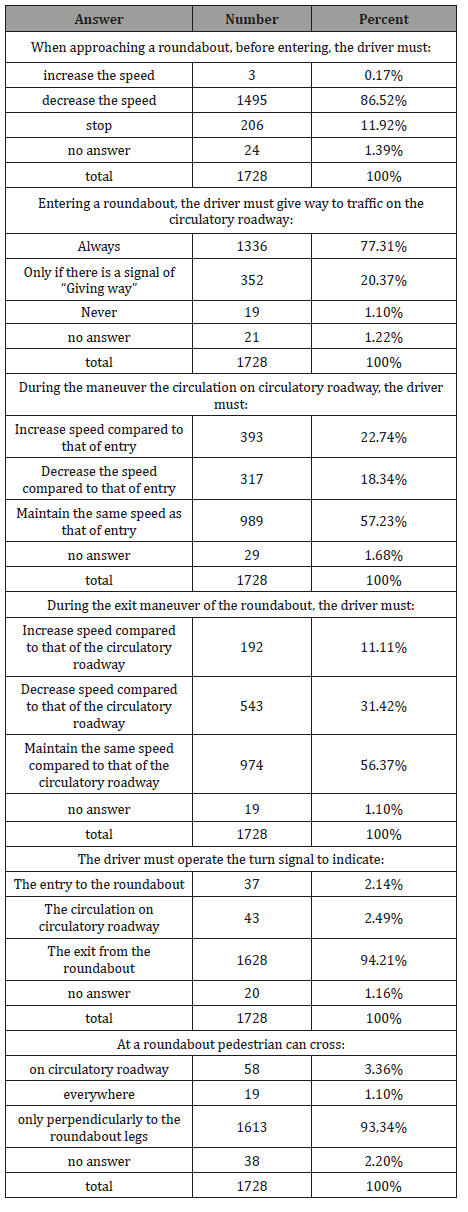
Analytical Method
In order to obtain a better understanding of road user perceptions of roundabouts, as well as to identify factors affecting these perceptions, a multivariate analysis is necessary. Particularly, discrete choice models provide an appropriate framework for conducting such an analysis. Furthermore, each of the response categories can be represented by a natural ordering structure (e.g., very favorable, favorable, unfavorable, very unfavorable). Ordered probability models are a form of discrete outcome models that relate dependent variables on an ordered discrete scale to a series of predictor variables. Ordered probability models are derived by defining a latent variable z as a basis for modeling ordinal ranking data.
z = βX + ε
where X is a vector of variables determining the discrete ordering for observation n,ε is a vector of estimable parameters, and β is a random disturbance. For this study, XLSTAT was used to estimate separate ordered probit models in order to examine public perceptions of roundabout. The judgments on roundabouts are assessed on a four-point scale. Table 3 presents the parameters of the ordered probit model developed (Table 3).
Table 3: Ordered Probit Model (normalized coefficients).
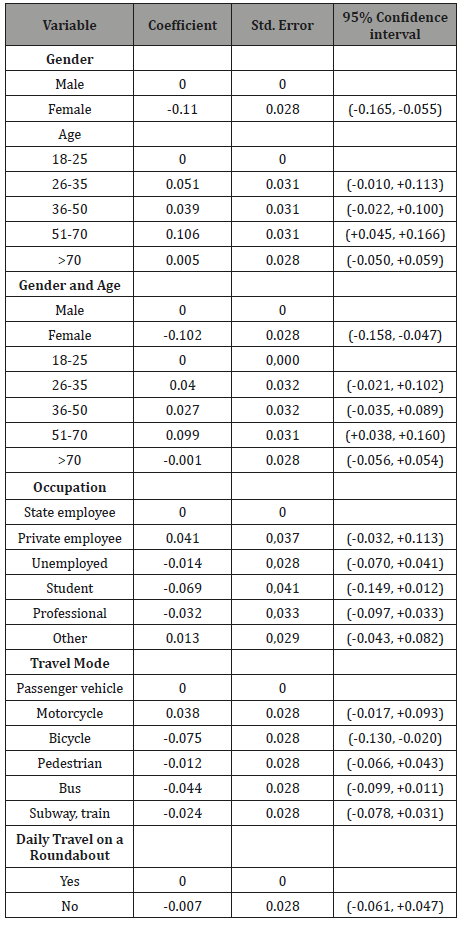
Result and Discussion
Following tables present the results of the ordered probit models that were used to examine public perceptions of roundabout related to the gender (Table 4), the age (Table 5), the age for gender (Tables 6 and 7), the occupation (Table 8), the travel mode (Table 9), and regular roundabout user or not (Table 10). (Tables 4-10)
Table 4:Ordered Probit Model of Perceptions of roundabout by gender.

Table 5:Ordered Probit Model of Perceptions of roundabout by age.

Table 6:Ordered Probit Model of Perceptions of roundabout by age and gender (only male).
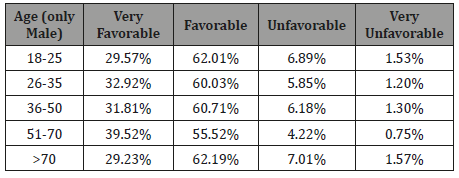
Table 7:Ordered Probit Model of Perceptions of roundabout by age and gender (only female).

Table 8:Ordered Probit Model of Perceptions of roundabout by occupation.
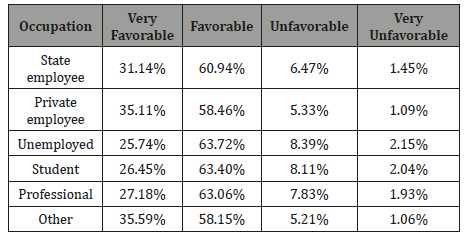
Table 9:Ordered Probit Model of Perceptions of roundabout by travel mode.

Table 10: Ordered Probit Model of Perceptions of roundabout by regular roundabout user or not.
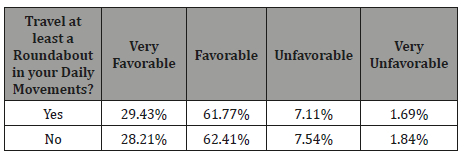
The results of statistical analysis on the responses to the web-surveys show that:
1. The positive judgment (very favorable + favorable) is almost equal between men and women; However, it should be noted that the percentage of people who said they were very favorable is higher among men (Table 4).
2. Young people between 18 and 25 years perceive the roundabouts less favorably than other age groups (Table 5).
3. The user’s category of users more favorable at roundabouts (very favorable) is constituted by men between 51 and 70 years (39.52%) (Table 6).
4. The category of users more unfavorable at roundabouts is represented by younger women (2.53%) and older ones (2.59%) (Table 7).
5. The social context, defined by the occupation, does not appear be a parameter that influences the public perception of the roundabouts (Table 8).
6. Among the categories of drivers, depending on the mode of transport, the motorcycle riders are the ones who, more than anyone, have a positive perception of the roundabouts (although it represents only 3.70% of respondents); the less favorable users are the cyclists (Table 9).
7. The users who travel at least on a roundabout for their daily movements, perceive the roundabouts in a similar way to infrequent users (Table 10).
Conclusion
The research literature has shown roundabouts to provide for improved safety and traffic operations in comparison to signalized and stop-controlled intersections. Even the engineers and traffic planners agree that the roundabouts, if well designed, are the best solution to optimize operational performance and the level of safety for users. Consistent with prior research, the results of this survey showed that public opinion is strongly in favor of the roundabouts with an average percentage of 90% (sum of all those who have expressed a judgment “very favorable” and those who said they were “favorable”). The statistical treatment of data by multivariate logistic analysis was done so on a representative sample of respondents from all regions of Italy. The results of this study thus provide the public perception of roundabouts as an expression of the entire Italian’s people. Therefore, these results provide a macroscopic view of road user perceptions of roundabouts at a statewide level. In this way, they have exceeded the limits associated with surveys carried out only in local areas. This study finally showed that web-based surveys provide an effective and efficient means of collecting detailed public opinion data.
Acknowledgment
We thank the DISS (Italian Center Road Safety) which allowed to publish the online survey. With support of the DISS has been possible to reach all University of Italy and many public and private administrations.
Conflict of Interest
No conflict of interest.
References
- Deery HA (1999) Hazard and Risk Perception among young novice drivers. Safety Research 30(4): 225-236.
- Brown ID, Groeger JA (1988) Risk perception and decision taking during the transition between novice and experienced driver status. Ergonomics 31: 585-597.
- Ram T, Chand K (2015) Effect of drivers’ risk perception on safe driving attitude. International Journal of Vehicle Safety 8(3): 218-232.
- Kouabenan DR (2002) Occupation, driving experience, and risk and accident perception. Journal of Risk Research 5(1): 49-68.
- Ma M, Yan X, Huang H, Abdel Aty M (2010) Occupational driver safety of public transportation: Risk perception, attitudes, and driving behavior. Journal of the Transportation Research Board 2145: 72-79.
- Rosenbloom T, Shahar A, Elharar A, Danino O (2008) Risk perception of driving as a function of advanced training aimed at recognizing and handling risks in demanding driving situations. Accident Analysis and Prevention 40(2): 697-703.
- Moen BE, Rundmo T (2006) Perception of transport risk in the Norwegian public. Risk Management 8(1): 43-60.
- Ulleberg P, Rundmo T (2003) Personality, attitudes and risk perception as predictors of risky driving behavior among young drivers. Safety Science 41 (5): 427-443.
- Iversen H (2004) Risk-taking attitudes and risky driving behavior. Transportation Research Part F: Traffic Psychology and Behaviour 7(3): 135-150.
- Distefano N, Leonardi S, Pulvirenti G (2018) Factors with the greatest influence on drivers’ judgment of roundabouts safety. An analysis based on web survey in Italy. In press IATSS Research 42(4): 265-273.
- Brilon W, Stuwe B (1991) Roundabouts-Capacity, safety, and design. Strassenverkehrstechnik Volume: 6.
- Persaud B, Retting RA, Garder PE, Lord D (2001) Observational beforeafter study of the safety effect of U.S. roundabout conversions using the empirical Bayes method. Transportation Research Record: Journal of the Transportation Research Board, N. 1751.
-
Natalia Distefano, Salvatore Leonardit. Italians’ Public Opinion on the Road Roundabouts Safety. Cur Trends Civil & Struct Eng. 1(5): 2019. CTCSE.MS.ID.000521.
-
Roundabouts, Road safety, Driving behaviour, Web survey, Risk perception, Ordered probit models, parameter, Traffic environment, Motorcycle riders, Survey
-

This work is licensed under a Creative Commons Attribution-NonCommercial 4.0 International License.






